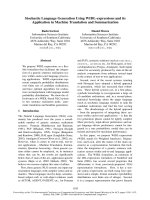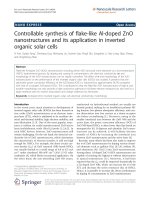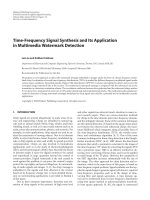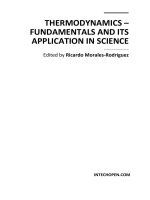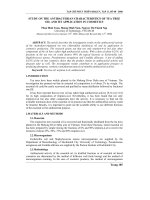An efficient and robust algorithm for incompressible flow and its application in heat transfer enhancement
Bạn đang xem bản rút gọn của tài liệu. Xem và tải ngay bản đầy đủ của tài liệu tại đây (2.28 MB, 251 trang )
AN EFFICIENT AND ROBUST ALGORITHM FOR
INCOMPRESSIBLE FLOW AND ITS APPLICATION IN
HEAT TRANSFER ENHANCEMENT
CHENG YONGPAN
NATIONAL UNIVERSITY OF SINGAPORE
2008
AN EFFICIENT AND ROBUST ALGORITHM FOR
INCOMPRESSIBLE FLOW AND ITS APPLICATION IN
HEAT TRANSFER ENHANCEMENT
CHENG YONGPAN
(B. Eng., M. Eng., Xian Jiaotong University, China)
A THESIS SUBMITTED
FOR THE DEGREE OF DOCTOR OF PHILOSOPHY
DEPARTMENT OF MECHANICAL ENGINEERING
NATIONAL UNIVERSITY OF SINGAPORE
2008
I
Acknowledgement
I would like to express my deepest gratitude to my supervisors, Assoc. Prof. Lee
Thong See and Assoc. Prof. Low Hong Tong for their continuous and invaluable
support, supervision and encouragement. Without their help, I cannot live through
my Ph.D study and finish my thesis.
When I am going to finish my Ph.D thesis, I cannot help remembering my former
supervisor in Xian Jiaotong University in China, the Academician of Chinese
Academy of Science, Prof. Tao Wen-quan, who led me to the field of Numerical
Heat Transfer in 2001. His “hardworking, aggressive, practical and cooperative”
attitude toward the research will benefit me for my whole life.
I would like to thank the kind colleagues in the Fluid Mechanics Laboratory, Shan
Yongyuan, Sui Yi, Wu Jie, Chen Xiaobing, Wang Liping etc. The discussion with
them inspired me with many new ideas.
I would like to express my deepest love to my dear wife, Wang Wei, who gave me
great love in my thesis preparation and defense; meanwhile, I would also like to
express sincere thanks to my dear parents and sisters for their long-time love,
support and understanding, which help me overcome the difficulty in the oversea
life.
Finally, I would like to thank National University of Singapore for offering the
research scholarship and valuable opportunity to pursue a Ph.D degree.
II
Table of Contents
Acknowledgement……………………………………………………………… I
Table of Contents……………………………………………………………… II
List of Figures……………………………………………………………….….VII
List of Tables………………………………………………………………… XV
Nomenclature……………………………………………………………… …XVI
Abbreviations………………………………………………………………… XXI
Summary………………………………………………………………… XXIII
Chapter 1 Introduction and Literature Review……………………………… 1
1.1 Background………………………………………………………………… 1
1.2 Development in heat transfer enhancement in fin-and-tube heat exchangers 4
1.2.1 Recent development in experimental study…………………………… 4
1.2.1.1 Plain fin-and-tube heat exchanger…………………………………5
1.2.1.2 Wavy fin-and-tube heat exchanger………………………… ……8
1.2.2 Recent development in numerical study……………………………… 11
1.2.2.1 Plain fin-and-tube heat exchanger……………………………… 12
1.2.2.2 Wavy fin-and-tube heat exchanger……………………………….15
1.3 Development in numerical algorithms for incompressible flow…………… 16
1.3.1 Numerical algorithms on staggered grid……………………………….20
1.3.2 Numerical algorithms on collocated grid………………………………24
III
1.4 Objectives and significance of the study…………………………………… 29
1.5 Outline of the thesis………………………………………………………… 31
Chapter 2 Grid Generation and Discretization of Governing Equations… 34
2.1 Requirement for grid…………………………………………………………34
2.2 Grid generation in two dimensions………………………………………… 37
2.3 Grid generation in three dimensions…………………………………………39
2.4 Discretization of governing equations……………………………………… 43
2.5 Implementation of high-order schemes………………………………………47
2.5.1 Normalized Variable and Space Formulation methodology…………… 47
2.5.2 Application of high-order schemes in equation discretization……… …49
Chapter 3 CLEARER Algorithm on Staggered Grid……………………… 57
3.1 General review of SIMPLER algorithm on staggered grid……………………57
3.2 Mathematical formulation of CLEARER algorithm………………………… 61
3.3 Numerical validation and comparison with SIMPLER algorithm………… 65
3.3.1 Lid-driven flow in a square cavity…………………………………… 66
3.3.2 Lid-driven flow in a polar cavity…………………………………… ….68
3.4 Concluding remarks…………………………………………………… …….69
Chapter 4 CLEARER Algorithm on Collocated Grid ……………………….81
4.1 General review of SIMPLER algorithm on collocated grid………………….81
IV
4.2 Mathematical formulation of CLEARER algorithm…………………………87
4.2.1 Discussion on SIMPLER algorithm……………………………………87
4.2.2 Improved SIMPLER algorithm……………………………………… 88
4.2.3 Discussion on the second relaxation factor…………………………….90
4.2.4 Treatment of solid region in computational domain………………… 91
4.2.4.1 Treatment of temperature field………………………………… 92
4.2.4.2 Treatment of flow field………………………………………… 93
4.3 Numerical validation and comparison with SIMPLER algorithm………… 94
4.3.1 Lid-driven flow in a square cavity…………………………………… 96
4.3.2 Natural convection in a square cavity………………………………….97
4.3.3 Lid-driven flow in a polar cavity……………………………………….97
4.3.4 Natural convection in an annular enclosure……………………………98
4.4 Concluding remarks………………………………………………………….99
Chapter 5 CLEARER Algorithm on Curvilinear Non-orthogonal Coordinates
………………………………………………………… 111
5.1 General review of SIMPLE algorithm on curvilinear non-orthogonal
coordinates…………………………………………………………………….111
5.2 Mathematical formulation of CLEARER algorithm……………………… 116
5.2.1 The predictor step of CLEARER algorithm………………………… 116
5.2.2 The corrector step of CLEARER algorithm………………………… 122
5.2.3 Solution procedure of CLEARER algorithm…………………………123
V
5.2.4 Discussion on the second relaxation factor ………………………….124
5.3 Numerical validation and comparison with SIMPLERM algorithm……… 126
5.3.1 Lid-driven flow in an inclined cavity…………………………………128
5.3.1.1 Lid-driven flow at Re=100…………………………………… 129
5.3.1.2 Lid-driven flow at Re=1000…………………………………….130
5.3.1.3 Lid-driven flow at Re=5000………………………………… …131
5.3.2 Natural convection in an inclined cavity…………………………… 132
5.3.3 Natural convection in an enclosure with eccentric cylinder and square
duct………………………………………………………………………….133
5.4 Investigation of minimum intersection angle among grid lines to guarantee
convergence…………………………………………………………………… 135
5.5 Concluding remarks……………………………………………………… 137
Chapter 6 Extension of CLEARER Algorithm to 3D Curvilinear
Non-orthogonal Coordinates……………………………………………… 158
6.1 Discretization of governing equations………………………………………158
6.2 Implementation of CLEARER algorithm………………………………… 162
6.2.1 The predictor step of CLEARER algorithm………………………… 162
6.2.2 The corrector step of CLEARER algorithm………………………… 167
6.3 Validation of CLEARER algorithm…………………………………………172
6.4 Concluding remarks……………………………………………………… 173
VI
Chapter 7 Application of CLEARER Algorithm to Triangular Wavy
Fin-and-Tube Heat Exchanger……………………………………………… 176
7.1 Physical model…………………………………………………………… 176
7.2 Mathematic description…………………………………………………… 177
7.2.1 Computational domain……………………………………………… 177
7.2.2 Boundary condition………………………………………………… 177
7.3 Brief introduction of field synergy principle……………………………… 178
7.4 Results and discussion………………………………………………………180
7.4.1 Mesh independence study…………………………………………….180
7.4.2 Influence of wavy angle………………………………………………181
7.4.3 Influence of fin pitch………………………………………………….182
7.4.4 Influence of tube diameter…………………………………………….184
7.4.5 Influence of wavy density…………………………………………….185
7.5 Concluding remarks……………………………………………………… 186
Chapter 8 Conclusions and Recommendations………………………… … 196
8.1 Conclusions……………………………………………………………… …196
8.2 Recommendations for future work………………………………………… 198
References………………………………………………………….………… 199
List of Publications……………………………………………… …………….223
VII
List of Figures
Figure 1.1Heat transfer surface area density spectrum of heat exchanger surface33
Figure 1.2 Various enhanced heat transfer fins………………………………… 33
Figure 2.1 The relation between the physical domain and computational domain54
Figure 2.2 Grid generated in 2D complex enclosure…………………………… 54
Figure 2.3 Grid generated in 3D wavy fin-and-tube heat exchanger………… 54
Figure 2.4 Computational grid and the definition of parameters……………… 55
Figure 2.5 Original and normalized variable and profiles……………………… 56
Figure 2.6 Control volumes for two-dimensional problem………………………56
Figure 2.7 Treatment of boundary condition…………………………………… 56
Figure 3.1 Control volumes of staggered grid in 2D Cartesian coordinates…… 71
Figure 3.2 Lid-driven flow in a square cavity……………………………………71
Figure 3.3 Convergence histories of SIMPLER, CLEARER, CLEAR1 and
CLEAR2………………………………………………………… 72
Figure 3.4 Accuracy test with fully developed flow in straight channel…… ……72
Figure 3.5 Comparison between predicted velocity distributions and benchmark
solutions at Re=100…………………………………………………73
Figure 3.6 Comparison between predicted velocity distributions and benchmark
solutions at Re=1000……………………………………………….73
Figure 3.7 Comparison between predicted velocity distributions and benchmark
solutions at Re=5000…………………………………………………74
VIII
Figure 3.8 Comparison of iteration numbers among SIMPLER, CLEARER,
CLEAR1 and CLEAR2 at Re=100…………………………………74
Figure 3.9 Comparison of iteration numbers among SIMPLER, CLEARER,
CLEAR1 and CLEAR2 at Re=1000……………………………… 75
Figure 3.10 Comparison of iteration numbers among SIMPLER, CLEARER at
Re=5000…………………………………………………………… 75
Figure 3.11 Comparison of iteration number ratio of CLEARER, CLEAR1, and
CLEAR2 over SIMPLER at Re=100……………………………….76
Figure 3.12 Comparison of iteration number ratio of CLEARER, CLEAR1 and
CLEAR2 over SIMPLER at Re=1000…………………………… 76
Figure 3.13 Comparison of iteration number ratio of CLEARER over SIMPLER
at Re=5000……………………………………………….………….77
Figure 3.14 Lid-driven flow in polar cavity…………………………………… 77
Figure 3.15 Comparison of streamlines at Re=350………………………………78
Figure 3.16 Comparison of streamlines at Re=1000…………………………….78
Figure 3.17 Comparison of iteration numbers among SIMPLER, CLEARER,
CLEAR1 and CLEAR2 at Re=350……………………………… 78
Figure 3.18 Comparison of iteration numbers among SIMPLER, CLEARER,
CLEAR1 and CLEAR2 at Re=1000………………………………79
Figure 3.19 Comparison of iteration number ratio of CLEARER, CLEAR1 and
CLEAR2 over SIMPLER at Re=350…………………………… 79
Figure 3.20 Comparison of iteration number ratio of CLEARER, CLEAR1 and
IX
CLEAR2 over SIMPLER at Re=1000…………………………….80
Figure 4.1 Control volumes of collocated grid in 2D Cartesian coordinates…….101
Figure 4.2 Influence of
γ
on the iteration number at
0.8
α
=
………………… 101
Figure 4.3 Influence of
β
on the iteration number at
0.8
α
=
………………….102
Figure 4.4 Accuracy test with fully developed flow in straight channel…… ….102
Figure 4.5. Pressure contour in lid-driven cavity at Re=5000……………………103
Figure 4.6 Comparison between predicted velocity distributions and benchmark
solutions at Re=1000…………………………………………… 103
Figure 4.7 Comparison between predicted velocity distributions and benchmark
solutions at Re=5000……………………………………………… 104
Figure 4.8 Comparison of iteration numbers between SIMPLER and CLEARER at
Re=1000………………………………………………………………104
Figure 4.9 Comparison of iteration numbers between SIMPLER and CLEARER
at Re=5000……………………………………………………………105
Figure 4.10 Ratio of iteration numbers of CLEARER vs. SIMPLER at
Re=1000…………… 105
Figure 4.11 Ratio of iteration numbers of CLEARER vs. SIMPLER at Re=5000.106
Figure 4.12 Comparison of iteration numbers between SIMPLER and
CLEARER………………………………………………………106
Figure 4.13 Ratio of iteration numbers of CLEARER vs. SIMPLER………….107
Figure 4.14 Lid-driven flow in polar cavity…………………………………… 107
Figure 4.15 Comparison of streamlines at Re=1000……………………………107
X
Figure 4.16 Comparison of iteration numbers between SIMPLER and
CLEARER……………………………………… …………….108
Figure 4.17 Ratio of iteration numbers of CLEARER vs. SIMPLER…………108
Figure 4.18 Natural convection in concentric cylinders……………………… 108
Figure 4.19 Comparison of streamlines and isothermals at
4
510Ra =×
……… 109
Figure 4.20 Comparison of distribution of local equivalent conductivity…… 109
Figure 4.21 Comparison of iteration numbers between SIMPLER and
CLEARER…………………………………………………….110
Figure 4.22 Ratio of iteration numbers of CLEARER vs. SIMPLER………… 110
Figure 5.1 Influence of second relaxation factor
β
on the iteration number at
0.2
α
= …………………………………………………………… ….139
Figure 5.2 Flow between two concentric cylinders……………………… …….139
Figure 5.3 Grid system in concentric cylinders at
0
10
θ
=
………………… ….139
Figure 5.4 Influence of grid size on the root mean square residual…………….140
Figure 5.5 Pressure contour in lid-driven cavity at Re=5000…………………….140
Figure 5.6 Geometry and boundary condition for lid-driven cavity………… …140
Figure 5.7 Grid system used in lid-driven cavity……………………………… 141
Figure 5.8 Streamlines at inclined cavity at
0
30
θ
=
Re=100………………….141
Figure 5.9 Streamlines at inclined cavity at
0
45
θ
=
Re=100………………….142
Figure 5.10 Comparison of centerline velocity profiles at
0
30
θ
=
Re=100…….142
Figure 5.11 Comparison of centerline velocity profiles at
0
45
θ
=
Re=100… 143
Figure 5.12 Comparison of iteration numbers between SIMPLERM and CLEARER
XI
at
0
45
θ
=
Re=100……………………………………………………143
Figure 5.13 Ratio of iteration number of CLEARER over SIMPLERM
at
0
45
θ
=
Re=100…………………………………………… 143
Figure 5.14 Streamlines at inclined cavity at
0
30
θ
=
Re=1000……………… 144
Figure 5.15 Streamlines at inclined cavity at
0
45
θ
=
Re=1000……………… 144
Figure 5.16 Comparison of centerline velocity profiles at
0
30
θ
=
Re=1000… 145
Figure 5.17 Comparison of centerline velocity profiles
0
45
θ
=
Re=1000…….145
Figure 5.18 Comparison of iteration numbers between SIMPLERM and CLEARER
0
45
θ
=
Re=1000……………………………………………………145
Figure 5.19 Ratio of iteration number of CLEARER over SIMPLERM at
0
45
θ
=
Re=1000………………………………………………… 145
Figure 5.20 Streamlines in inclined lid-driven cavity at Re=5000……………….146
Figure 5.21 Centerline velocity profiles at
0
45
θ
=
Re=5000………………… 146
Figure 5.22 Comparison of iteration numbers between SIMPLERM and CLEARER
at
0
45
θ
=
, Re=5000…………………………………………………147
Figure 5.23 Ratio of iteration numbers of CLEARER over SIMPLERM at
0
45
θ
=
,
Re=5000………………………………………………………………147
Figure 5.24 Geometry and boundary condition for natural convection in inclined
cavity…………………………………………………………… 148
Figure 5.25 Streamlines in inclined cavity at
Pr 0.1
=
……………………………148
Figure 5.26 Isothermals in inclined cavity at
Pr 0.1
=
……………………………148
Figure 5.27 Streamlines in inclined cavity at
Pr 10
=
…………………………….149
XII
Figure 5.28 Isothermals in inclined cavity atPr 10
=
………………………… 149
Figure 5.29 Comparison of
Nu along the hot wall at Pr=0.1…………………… 149
Figure 5.30 Comparison of
Nu along the hot wall at Pr=10…………………… 150
Figure 5.31 Comparison of iteration numbers between SIMPLERM and
CLEARER……………………………………………………… 150
Figure 5.32 Ratio of iteration numbers of CLEARER over SIMPLERM……… 150
Figure 5.33 Geometry and boundary condition for natural convection between
eccentric cylinders………………………………………………… 151
Figure 5.34 Streamlines between eccentric cylinders at Pr=0.1……………… 151
Figure 5.35 Isothermals between eccentric cylinders at Pr=0.1……………… 152
Figure 5.36 Streamlines between eccentric cylinders at Pr=10………………… 152
Figure 5.37 Isothermals between eccentric cylinders at Pr=10………………… 153
Figure 5.38 Comparison of
Nu along the cold wall at Pr=0.1……………………153
Figure 5.39 Comparison of
Nu along the hot wall at Pr=0.1…………………… 154
Figure 5.40 Comparison of
Nu along the cold wall at Pr=10………………… 154
Figure 5.41 Comparison of
Nu along the hot wall at Pr=10…………………… 154
Figure 5.42 Comparison of iteration number between SIMPLERM and
CLEARER…………………………………………………… 155
Figure 5.43 Ratio of iteration numbers of CLEARER over SIMPLERM……….155
Figure 5.44 Coarse grid system in inclined cavity…………………………… 155
Figure 5.45 Streamlines in lid-driven cavity flow when inclination angle
0
5
θ
=
155
Figure 5.46 Velocity distribution along the centerlines when inclination angle
XIII
0
5
θ
=
………………………………………………………………156
Figure 5.47 Convergence history at inclination angle
0
5
θ
=
………………… 156
Figure 5.48 Natural convection in inclined cavity when inclination angle
0
5
θ
=
………………………………………………………….156
Figure 5.49 Nu distribution along the hot wall when inclination angle
0
5
θ
=
157
Figure 6.1 Coordinate transformation and definition of parameters…………… 174
Figure 6.2 Fluid flow in a square duct with 90-degree bend…………………… 174
Figure 6.3 Grid system in a square duct with 90-degree bend……………………174
Figure 6.4 Comparison between predicted and experimental results…………….175
Figure 6.5 Comparison between present and experimental results… ……… 175
Figure 7.1 Geometric parameters and computational domain….………………188
Figure 7.2 Fluid Flow and heat transfer over a backward step…………………189
Figure 7.3 Nusselt number variation with grid number……………………… 189
Figure 7.4 Influence of wavy angle on the friction factor under different Reynolds
numbers…………………………………………………………… 189
Figure 7.5 Influence of wavy angle on the Nusselt number under different
Reynolds numbers…………………………………………………….190
Figure 7.6 Comparison of synergy angle with different wavy angle under different
Reynolds numbers………………………………………………….190
Figure 7.7 Influence of fin pitch on the friction factor under different Reynolds
Numbers………………………………………………………… 191
Figure 7.8 Influence of fin pitch on the Nusselt number under different Reynolds
XIV
Numbers…………………………………………………………….191
Figure 7.9 Comparison of synergy angle with different fin pitches under different
Reynolds numbers………………………………………………… 192
Figure 7.10 Influence of tube diameter on the friction factor under different
Reynolds numbers…………………………………………………192
Figure 7.11 Influence of tube diameter on the Nusselt number under different
Reynolds numbers…………………………………………………193
Figure 7.12 Comparison of synergy angle with different tube diameters under
different Reynolds numbers……………………………………….193
Fig. 7.13 Influence of wavy number on the friction factor under different Reynolds
numbers.………………………………………………………………194
Figure 7.14 Influence of wavy number on the Nusselt number under different
Reynolds numbers…………………………………………………194
Figure 7.15 Comparison of synergy angle with different wavy numbers under
different Reynolds…………………………………………………195
XV
List of Tables
Table 2.1 Expressions of
(
)
A
P
Δ
for several schemes…………………………….52
Table 2.2 Definition of normalized variable for some schemes………………… 52
Table 3.1 Some correspondence between
α
and E ………………………… 71
Table 4.1 Comparison of predicted results with benchmark solutions at
5
10Ra =
101
Table 5.1 Comparison of average Nu, maximum Nu and its position………… 138
Table 5.2 Comparison of average Nu, maximum Nu and its position at Pr=0.1 138
Table 5.3 Comparison of average Nu, maximum Nu and its position at Pr=10…138
Table 7.1 Simulation conditions……………………………………………… 188
XVI
Nomenclature
a
Thermal diffusivity
P
a ,
E
a ,
W
a ,
N
a ,
S
a
Coefficients in the discretized equation
A
Surface area
P
A ,
E
A ,
W
A ,
N
A ,
S
A ,
T
A ,
D
A
Coefficients in the discretized equation
b
Source term
B
,C
Coefficient in pressure or pressure correction
equation
p
c
Specific heat at constant pressure
D
Diffusion conductivity
e
D
Tube diameter
E
Time step multiple
f
Friction factor
f
+
,
f
−
Interpolation factors
F
Flow rate
p
F
Fin pitch
ch
Flow
Characteristic flow rate
g
Gravitational acceleration
h
Heat transfer coefficient
J
Geometric factor
eq
K
Equivalent conductivity
XVII
l
Arc length
L
Length of cavity; Fin length
m
Mass flux
Nu
Nusselt number
p
Pressure
p
ξ
,
p
η
Average pressure gradients
*
p
Temporary pressure
p
′
Pressure correction
P
Source term in Poisson equation
l
P
Longitudinal tube pitch
t
P
Transverse tube pitch
Pr
Prandtl number
Q
Source term in Poisson equation; Heat transfer rate
R
Source term in Poisson equation; Radius
R
a
Rayleigh number
Re
Reynolds number
max
R
Maximum relative mass flow rate unbalance
s
Control volume surface area
S
Source term
T
Temperature
u ,v ,w
Velocity components
*
u ,
*
v ,
*
w
Temporary velocities
XVIII
u ,v
,
i
w
Pseudo velocities
u
′
,v
′
, w
′
Velocity corrections
U ,V ,W
Contravariant velocities at interface;
Non-dimensional velocities
*
U
,
*
V
,
*
W
Temporary contravariant velocities
i
U ,
i
V ,
i
W
Pseudo contravariant velocities
U
′
,V
′
,W
′
Contravariant velocity corrections
Lid
U
Moving velocity of lid
V
Control volume
x
,
y
, z
Coordinates in physical domain
x
ξ
,
x
η
,
x
ζ
,
y
ξ
,
y
η
,
y
ζ
,
z
ξ
z
η
z
ζ
Geometric factors
X
,
Y
,
Z
Dimensionless coordinates
Greek symbols
α
Underrelaxation factor; Geometric factor;
Wavy angle
β
Second relaxation factor; Geometric factor;
Volume expansion coefficient
δ
Gap between two concentric cylinders
x
δ
,
y
δ
,
z
δ
Distances between two adjacent grid points
in
x
,
y
and z directions
XIX
δ
ξ
,
δ
η
,
δ
ζ
Distance between two adjacent grid points in
ξ
,
η
and
ζ
directions
φ
General variable; Source term in Poisson equation
γ
Geometric factor; Underrelaxation factor
η
Dynamic viscosity
λ
Thermal conductivity
ν
Kinematic viscosity
θ
Radian in polar cavity;
Local synergy angle
θ
Average synergy angle
ρ
Density
ω
Source term in Poisson equation; Angular velocity
ξ
,
η
,
ζ
Coordinates in computational domain
ψ
Source term in Poisson equation
TΔ
Temperature difference
VΔ
Control volume
x
Δ
,
y
Δ , zΔ
Distances between two adjacent interfaces in
in
x
,
y
and z directions
ξ
Δ ,
η
Δ ,
ζ
Δ Distances between two adjacent interfaces in
ξ
,
η
and
ζ
directions
Γ
Nominal diffusion coefficient
XX
Superscripts
u ,v ,w Coefficients related to uvand wvelocity
0
Resolution of the previous iteration
*
Intermediate value
Subscripts
Ave Average
C
Central
D
Downstream
e ,w,n ,s ,t,d
Cell face
f
Interface
in Inner; Inlet
m Mean
max Maximum
mi
n
Minimum
nb Neighboring grid points
out Outlet
p
Refers to pressure
P , E ,W , N ,S ,T , D
Grid points
T
Refers to temperature
u ,v ,w refers to uv and w velocity
U
Upstream
w Wall
XXI
Abbreviations
ADI Alternative Direction Implicit method
BEM Boundary Element Method
CD Central Difference
CLEAR Coupled and Linked Equation Algorithm Revised
CVFEM Control-Volume Finite Element Method
DQM Differential Quadrature Method
ES Exponential Scheme
FAM Finite Analytic Method
FDM Finite Difference Method
FEM Finite Element Method
FIMOSE Fully Implicit Method for Operator-Split Equation
FUD First-order Upwind Difference
FVM Finite Volume Method
HS Hybrid Scheme
ITM Integral Transformation Method
LBM Lattice-Boltzmann Method
MMIM Modified Momentum Interpolation Method
MSIMPLER Modified SIMPLER
NVSF Normalized Variable and Space Formulation
PIV Particle Image Velocimetry
XXII
PLS Power Law Scheme
QUICK Quadratic Upwind Interpolation of Convective
Kinematics
SGSD Stability Guaranteed Second-order Difference
SIMPLE Semi-Implicit Method for the Pressure-Linked
Equation
SIMPLEC SIMPLE Consistent
SIMPLEM SIMPLE Modified
SIMPLER SIMPLE Revised
SIMPLERM SIMPLER Modified
SIMPLEX SIMPLE eXtrapolation
SM Spectral Method
SUD Second-order Upwind Difference
PISO Pressure Implicit Split-Operator
XXIII
Summary
The fluid flow and heat transfer in complex geometries are often encountered in
industrial applications; hence an efficient and robust algorithm is needed to
numerically simulate the complex flow and heat transfer accurately. In this thesis,
based on the detailed study on the SIMPLE-like algorithms, a novel algorithm
named CLEARER was formulated for the incompressible flow on staggered grid,
collocated orthogonal grid and non-orthogonal curvilinear grid respectively.
On the staggered grid, it was proven that current CLEARER algorithm can predict
the numerical results accurately; moreover, the convergence rate can be more stable
by virtue of pressure correction instead of pressure in the correction stage. On the
collocated grid, CLEARER algorithm can also predict the numerical results
accurately, and the convergence rate and robustness of CLEARER algorithm are
much higher that those of the companion SIMPLE-like algorithms. The CLEARER
algorithm can not only guarantee the fully coupling between pressure and velocity,
the geometric and physical conservation, but also the solution independence of
under-relaxation factor. Furthermore, with the simplified pressure correction
equation, CLEARER algorithm can also overcome the very severe grid
non-orthogonality, even when the intersection angle among gridlines is 1 degree.
The CLEARER algorithm was then extended to three-dimensional non-orthogonal
curvilinear coordinate and was adopted to solve the periodically developed flow in
the triangular wavy fin-and-tube heat exchanger. The influence of wavy angle,
wavy density, fin pitch and tube diameter on the pressure drop and heat transfer


